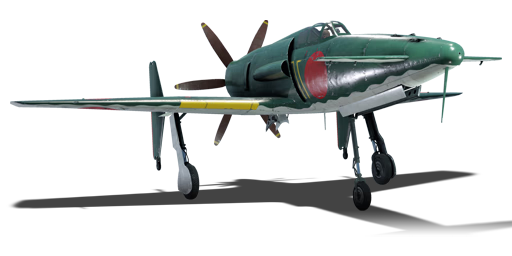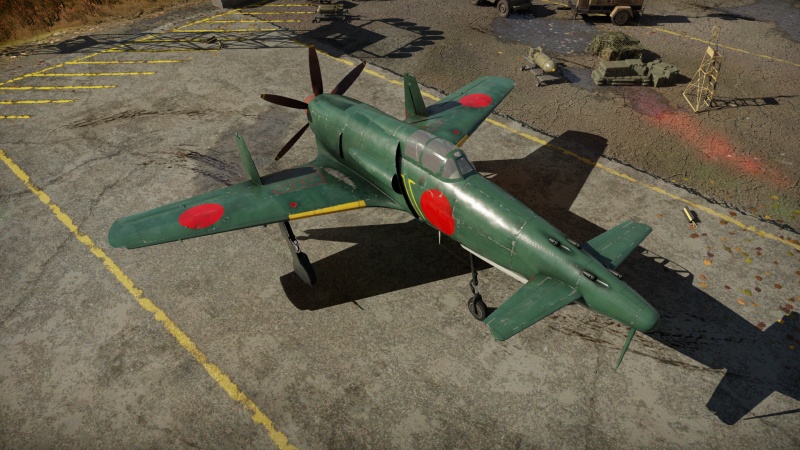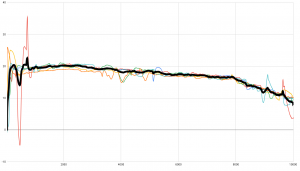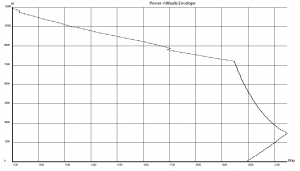Difference between revisions of "J7W1"
(Tag: Visual edit) |
|||
| Line 8: | Line 8: | ||
The '''{{Specs|name}}''' is a rank {{Specs|rank}} Japanese fighter {{Battle-rating}}. It was introduced in [[Update 1.43]]. | The '''{{Specs|name}}''' is a rank {{Specs|rank}} Japanese fighter {{Battle-rating}}. It was introduced in [[Update 1.43]]. | ||
| − | The J7W1 Shinden is a bomber interceptor designed to make quick work of raiding bomber aircraft. It has | + | The J7W1 Shinden is a bomber interceptor designed to make quick work of raiding bomber aircraft. It has exceptional performance at altitude, more than exceptional armament and a decent climb rate. Double the weight of a fully loaded A6M, and definitely heaps faster to make up for it. This aircraft thrives with boom and zoom, and has a great energy retention at speed due to sleek aerodynamics. Inherently less stable than a normal tail plane thanks to a rear mounted engine push thrust configuration canard design, it is known for rapid pitch angle changes, great roll rate and less drag, by design. The flap system does not work in game currently however it enhances negative G two fold, at the cost of your speed. The aircraft is very prone to fires however, a single hit to the fuel tanks will result in an inextinguishable flame that will for sure be your demise. |
== General info == | == General info == | ||
Revision as of 23:14, 25 March 2021
Contents
Description
The J7W1 Shinden is a rank Japanese fighter with a battle rating of (AB), (RB), and (SB). It was introduced in Update 1.43.
The J7W1 Shinden is a bomber interceptor designed to make quick work of raiding bomber aircraft. It has exceptional performance at altitude, more than exceptional armament and a decent climb rate. Double the weight of a fully loaded A6M, and definitely heaps faster to make up for it. This aircraft thrives with boom and zoom, and has a great energy retention at speed due to sleek aerodynamics. Inherently less stable than a normal tail plane thanks to a rear mounted engine push thrust configuration canard design, it is known for rapid pitch angle changes, great roll rate and less drag, by design. The flap system does not work in game currently however it enhances negative G two fold, at the cost of your speed. The aircraft is very prone to fires however, a single hit to the fuel tanks will result in an inextinguishable flame that will for sure be your demise.
General info
Flight performance
The J7W1 Shinden has a maximum speed of 892 km/h (558 mph/485 kt) IAS (this is Vne speed - the absolute maximum speed). In a dive from service ceiling, a speed of mach 0.9 has been recorded and is sustained until IAS speed limit is reached. The aircraft can handle a max load of 11G and compresses rudder, pitch and roll at extremely high IAS speed in order of descending effect.
| Characteristics | Max Speed (km/h at 8,500 m) |
Max altitude (meters) |
Turn time (seconds) |
Rate of climb (meters/second) |
Take-off run (meters) | |||
|---|---|---|---|---|---|---|---|---|
| AB | RB | AB | RB | AB | RB | |||
| Stock | 723 | 703 | 31.5 | 32.2 | 15.3 | 15.3 | 650 | |
| Upgraded | 779 | 750 | 28.6 | 30.0 | 23.0 | 18.6 | ||
Details
| Features | ||||
|---|---|---|---|---|
| Combat flaps | Take-off flaps | Landing flaps | Air brakes | Arrestor gear |
| ✓ | ✓ | ✓ | X | X |
| Limits | ||||||
|---|---|---|---|---|---|---|
| Wings (km/h) | Gear (km/h) | Flaps (km/h) | Max Static G | |||
| Combat | Take-off | Landing | + | - | ||
| 498 | 469 | 320 | ~8 | ~6 | ||
| Optimal velocities (km/h) | |||
|---|---|---|---|
| Ailerons | Rudder | Elevators | Radiator |
| < 563 | < 560 | < 560 | > 314 |
| Compressor (RB/SB) | ||
|---|---|---|
| Setting 1 | ||
| Optimal altitude | 100% Engine power | WEP Engine power |
| 8,400 m | 1,660 hp | 1,942 hp |
Survivability and armour
- 70 mm Bulletproof glass - Armoured windscreen
- 16 mm Steel plate in the nose, in front of ammo boxes and pilot
The J7W1 is protected by armour glass (70 mm) in front of pilot and steel armour plate (16 mm) in front of pilot in between guns. It is very prone to fires, and which are difficult to extinguish. Engine snipes are common, due to the position of the engine. Wing tip damage can increase the likelyhood of unrecoverable flat spins.
Modifications and economy
Armaments
Offensive armament
The J7W1 is armed with:
- 4 x 30 mm Type 5 navy cannons, nose-mounted (60 rpg = 240 total)
- Muzzle velocities
- Shells: HEF-T, PT, P: 910 m/s
- Shells: HEF-I, HEF: 720 m/s
- Tracer: 910 m/s
- All other belts: Mixed shell velocities, see above.
Suspended armament
The J7W1 can be outfitted with the following ordnance:
- Without load
- 2 x 60 kg Navy Type 97 Number 6 bombs (120 kg total)
- 4 x 60 kg Navy Type 97 Number 6 bombs (240 kg total)
Usage in battles
The Shinden is a quick, pusher prop aircraft that excels in keeping its energy up after diving from a high altitude. It is able to climb up to a nice altitude above its opponents and strafe enemies either with a "boom and zoom" or "hit and run" strategy. The Shinden sports four excellant 30mm guns mounted in the nose making it infamous for its head on capabilities as they are easy to get on target but require a bit of aim control as the guns are low velocity, as long as you keep your speed high you will become a big threat to the enemy team. The Shinden is able to outrun a myriad of aircraft at its BR with some exceptions being the F8F-1B and the Spitfire F MK XIVe as they have more powerful engines. Enemy bombers such as the B-17G-60-VE are optimal targets as your main weapons are able to quickly rip through the bombers armor, heavy fighters such as the F7F-1 or the Hornet Mk.III are targets you may often see at your altitude and make for great prey as they are large and aren't as agile as single engine fighters. As a Shinden pilot it is unwise to let the enemy get onto your six o'clock as you aren't likely to shake them due to the poor maneuverability and that the Shindens engine is mounted in the rear of the plane, meaning any enemy behind you can quickly take you out of the fight just with a few hits to the engine. Like a majority of the Japanese planes the Shinden lacks any armor to reliable stop bullets from damaging it, however there is a piece of bulletproof glass in the front of the planes cockpit that is 70 millmeters thick as well as a 16 millimeter steel plate in the nose, making head ons a reliable way to kill enemy aircraft as you do not have to worry about enemy bullets hitting your engine. It is highly recommended to avoid partcipating in dogfights in the Shinden as almost any single prop fighter at its BR will be able to out turn it so its ideal to stick to energy fighting. The Shinden also has access to 60 kg bombs that can destroy lightly armoured targets in mixed battles.
Manual Engine Control
| MEC elements | ||||||
|---|---|---|---|---|---|---|
| Mixer | Pitch | Radiator | Supercharger | Turbocharger | ||
| Oil | Water | Type | ||||
| Controllable | Controllable Auto control available |
Not controllable Not auto controlled |
Controllable Auto control available |
Combined | Not controllable 1 gear |
Not controllable |
Pros and cons
Pros:
- Pilot has some protection in the back from the engine.
- Competitive high speed turn rate
- Good roll rate
- Amazing pitch response
- 4 x 30 mm cannons make for some great offensive firepower.
- Great high speed and handling and dive.
- Since the engine and propeller are located in the rear, it is not likely to take damage or catch fire from shots landing at its front.
Cons:
- Slow sustained turn rate.
- High speed rudder suffers some compression
- Pilot more exposed at the front.
- Since the engine is located in the rear, it is especially vulnerable to enemies behind it.
- Shots to the front may damage its "tail" flaps.
- Armament may detonate
- Fuel tanks are easily flammable and do not self seal fully.
History
The J7W1 Shinden (震電, "Magnificent Lightning") was an Imperial Japanese fighter of WWII that was built near the end of the war in an attempted response to the American B-29 Superfortress bombers. The aircraft used a canard wing formation, (canard wing formation refers to how the main wings are mounted at the rear of the fuselage and smaller wings are placed at the front. Similar to the Curtiss-Wright XP-55 Ascender.) Like the Ascender, the J7W1 was never put into mass-production and was abandoned while still in the prototype stage.[1]
Developed with the intention of intercepting heavy bombers, it was given 4 nose-mounted 30 mm cannons.
Development of the aircraft began in 1944, but shortages of manufacturing supplies continued to delay its development and testing and the first prototype wasn't completed until April 1945. The Navy placed high hopes in the new model and it was originally hoped that the Kyushu's Zasshonokuma factory and Nakajima's Handa plant would be able to produce over a thousand of the aircraft by 1947.
The prototype first flew on 3 August 1945 from Itazuke Air Base. The plane flew a total of three times, each time as a test flight before it was grounded permanently due to the Japanese surrender and end of the war.
Various parts of the Shinden survived the end of the war and its fuselage can be seen at the National Air and Space Museum in Washington DC.[2]
Media
- Skins
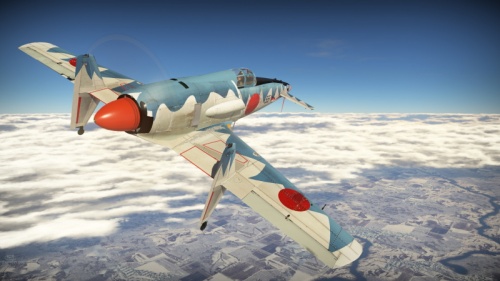

- Videos
See also
- Aircraft of comparable role, configuration and era
External links
- [Profile] J7W1 Shinden - The magnificent lightning
- [Forum] Aircraft Datasheet
- [Wikipedia] Kyushu J7W
References
| Kyūshū Aircraft Co. Ltd. (九州飛行機株式会社) | |
|---|---|
| Fighters | J7W1 |
| Previously known as Watanabe Iron Works Co. Ltd. (渡辺鉄工株式会社) prior to 1943 before being split into Kyūshū Aircraft & Kyūshū Weapons. | |
| Japan fighters | |
|---|---|
| Navy | |
| Carrier-based fighter | |
| A5M | A5M4 · Hagiri's A5M4 |
| A6M | A6M2 mod. 11 · A6M2 · A6M3 · A6M3 mod. 22 · A6M3 mod. 22Ko · A6M5 · A6M5 Ko · A6M5 otsu · A6M5 Hei · A6M6c |
| A7He | A7He1* |
| A7M | A7M1 (NK9H) · A7M2 |
| Land-based Fighter | |
| J2M | J2M2 · J2M3 · J2M4 Kai · J2M5 · J2M5 (30 mm) |
| J6K | J6K1 |
| J7W | J7W1 |
| N1K-J | N1K1-Ja · N1K2-J · N1K2-Ja |
| Fighter seaplane | |
| N1K | N1K1 |
| A6M-N | A6M2-N |
| Army | |
| Ki-10 | Ki-10-I · Ki-10-I C · Ki-10-II · Ki-10-II C |
| Ki-27 | Ki-27 otsu · Ki-27 otsu Tachiarai |
| Ki-43 | Ki-43-I · Ki-43-II · Ki-43-III otsu |
| Ki-44 | Ki-44-I · Ki-44-I 34 · Ki-44-II otsu · Ki-44-II hei |
| Ki-61 | Ki-61-I ko · Ki-61-I otsu · Ki-61-I hei · Tada's Ki-61-I hei · Ki-61-I tei · Ki-61-II Otsu Kai |
| Ki-84 | Ki-84 ko · Ki-84 otsu · Ki-84 hei |
| Ki-87 | Ki-87 |
| Ki-94 | Ki-94-II |
| Ki-100 | Ki-100 · Ki-100-II |
| Other countries | ▅F4U-1A · ▅P-51C-11-NT · ▅Bf 109 E-7 · ▅Fw 190 A-5 |
| *Imported designation of the He 112 (A6M was in development - A7M would take A7 designation after the cancelation of the A7He) | |


